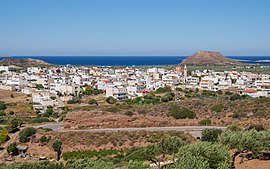Palaikastro
Παλαίκαστρο | |
|---|---|
 Panorama looking ENE into the Strait of Kasos over the town from some high ground to the west. | |
| Coordinates: 35°12′N 26°15′E / 35.200°N 26.250°E | |
| Country | Greece |
| Administrative region | Crete |
| Regional unit | Lasithi |
| Municipality | Siteia |
| Municipal unit | Itanos |
| Population (2021)[1] | |
| • Community | 1,254 |
| Time zone | UTC+2 (EET) |
| • Summer (DST) | UTC+3 (EEST) |
| Website | http://www.palaikastro.com/ |
Palaikastro or Palekastro (Greek: Παλαίκαστρο, officially Greek: Παλαίκαστρον), with the Godart and Olivier abbreviation PK, is a thriving town, geographic heir to a long line of settlements extending back into prehistoric times, at the east end of the Mediterranean island Crete. The Kallikratis Programme implemented starting 2011 made the town into a local community (topiki koinoteta) under jurisdiction of the next-highest levels, chained as follows: municipal unit (demotike enoteta) Itanos, municipality (demos) Sitia, regional unit (periphereiakes enotetas) Lasithi, region (periphereia) Crete.[2]
Until 2017 Palaikastro shared Itanos with Karydi, Zakros, and Mitato (Μητάτο). The latter was located on an altiplano to the west. It had 6 villages, including Mitato ("hut"), named after an ancient stone shepherd's mitato of interest to visitors. However, subsequently the population on the plain diminished to the point where Mitato village had no permanent residents. Consequently, by Presidential Decree No. 70/207, on recommendation of the Minister of the Interior, and approval by Sitia and Palaikastro, K. Mitato was phased out and its settlements were turned over to Palaikastro, which had been collecting the population, and providing the services, anyway.[3]
- ^ "Αποτελέσματα Απογραφής Πληθυσμού - Κατοικιών 2021, Μόνιμος Πληθυσμός κατά οικισμό" [Results of the 2021 Population - Housing Census, Permanent population by settlement] (in Greek). Hellenic Statistical Authority. 29 March 2024.
- ^ "Palekastro". buk.gr. Retrieved 7 February 2022.
- ^ "Συγχώνευση Τοπικών Κοινοτήτων Μητάτου και Παλαικάστρου Ιτάνου Σητείας ("Merger of Local Communities of Mitatos and Palekastro Itanos of Sitia")". Καλλικράτης. 27 July 2017.

